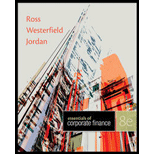
Case synopsis:
Company S is a real estate firm, whose CEO (chief executive officer) is Person R. The firm buys real estate and rents it to tenants. The firm has profit for each year. Before the foundation of Company S, Person R was the founder and CEO of Company A, which is a farming operation. Company A was a failure firm, which ended up with bankruptcy. This situation made Person R to be extremely averse towards debt financing.
Hence, the company is completely financed through equity. Company S is assessing a plan to buy a huge tract of land, which would be leased to the tenant farmers. This purchase is predicted to raise the annual earnings before tax in perpetuity. Person J is the new CFO (Chief financial officer) of Company S, who found the present capital cost of the company.
Person J felt that the company will be very valuable, if it adds debt in its capital structure. While evaluating whether the company could issue debt to completely finance the project, she found that it can issue bonds at a par value with coupon rate. She found an optimal range of capital structure between 70% equity and 30% debt.
Characters in the case:
- Company S
- Company A
- Person S
- Person J
Adequate information:
- If Company S moves beyond the 30% debt, the bonds issued by the company will have a lower rating and a greater coupon as the possibility of financial distress and the associated cost will increase.
- Company S also has a corporate rate of tax.
To discuss: Whether Person X will suggest equity or debt to finance the purchase of land, if Person S wants to expand the market value of the company.
Want to see the full answer?
Check out a sample textbook solution
Chapter 13 Solutions
Essentials of Corporate Finance
- Scenario three: If a portfolio has a positive investment in every asset, can the expected return on a portfolio be greater than that of every asset in the portfolio? Can it be less than that of every asset in the portfolio? If you answer yes to one of both of these questions, explain and give an example for your answer(s). Please Provide a Referencearrow_forwardHello expert Give the answer please general accountingarrow_forwardScenario 2: The homepage for Coca-Cola Company can be found at coca-cola.com Links to an external site.. Locate the most recent annual report, which contains a balance sheet for the company. What is the book value of equity for Coca-Cola? The market value of a company is (# of shares of stock outstanding multiplied by the price per share). This information can be found at www.finance.yahoo.com Links to an external site., using the ticker symbol for Coca-Cola (KO). What is the market value of equity? Which number is more relevant to shareholders – the book value of equity or the market value of equity?arrow_forward
- FILE HOME INSERT Calibri Paste Clipboard BIU Font A1 1 2 34 сл 5 6 Calculating interest rates - Excel PAGE LAYOUT FORMULAS DATA 11 Α΄ Α΄ % × fx A B C 4 17 REVIEW VIEW Alignment Number Conditional Format as Cell Cells Formatting Table Styles▾ Styles D E F G H Solve for the unknown interest rate in each of the following: Complete the following analysis. Do not hard code values in your calculations. All answers should be positive. 7 8 Present value Years Interest rate 9 10 11 SA SASA A $ 181 4 $ 335 18 $ 48,000 19 $ 40,353 25 12 13 14 15 16 $ SA SA SA A $ Future value 297 1,080 $ 185,382 $ 531,618arrow_forwardB B Canning Machine 2 Monster Beverage is considering purchasing a new canning machine. This machine costs $3,500,000 up front. Required return = 12.0% Year Cash Flow 0 $-3,500,000 1 $1,000,000 2 $1,200,000 3 $1,300,000 4 $900,000 What is the value of Year 3 cash flow discounted to the present? 5 $1,000,000 Enter a response then click Submit below $ 0 Submitarrow_forwardFinances Income Statement Balance Sheet Finances Income Statement Balance Sheet Materia Income Statement Balance Sheet FY23 FY24 FY23 FY24 FY23 FY24 Sales Cost of Goods Sold 11,306,000,000 5,088,000,000 13,206,000,000 Current Current Assets 5,943,000,000 Other Expenses 4,523,000,000 5,283,000,000 Cash 211,000,000 328,600,000 Liabilities Accounts Payable 621,000,000 532,000,000 Depreciation 905,000,000 1,058,000,000 Accounts 502,000,000 619,600,000 Notes Payable 376,000,000 440,000,000 Earnings Before Int. & Tax 790,000,000 922,000,000 Receivable Interest Expense 453,000,000 530,000,000 Total Current Inventory 41,000,000 99,800,000 997,000,000 972,000,000 Taxable Income 337,000,000 392,000,000 Liabilities Taxes (25%) 84,250,000 98,000,000 Total Current 754,000,000 1,048,000,000 Long-Term Debt 16,529,000,000 17,383,500,000 Net Income Dividends 252,750,000 294,000,000 Assets 0 0 Fixed Assets Add. to Retained Earnings 252,750,000 294,000,000 Net Plant & 20,038,000,000 21,722,000,000…arrow_forward
- Do you know what are Keith Gill's previous projects?arrow_forwardExplain why long-term bonds are subject to greater interest rate risk than short-term bonds with references or practical examples.arrow_forwardWhat does it mean when a bond is referred to as a convertible bond? Would a convertible bond be more or less attractive to a bond holder than a non-convertible bond? Explain in detail with examples or academic references.arrow_forward
- Alfa international paid $2.00 annual dividend on common stock and promises that the dividend will grow by 4% per year, if the stock’s market price for today is $20, what is required rate of return?arrow_forwardgive answer general accounting.arrow_forwardGive me answers in general financearrow_forward
 Financial Accounting: The Impact on Decision Make...AccountingISBN:9781305654174Author:Gary A. Porter, Curtis L. NortonPublisher:Cengage Learning
Financial Accounting: The Impact on Decision Make...AccountingISBN:9781305654174Author:Gary A. Porter, Curtis L. NortonPublisher:Cengage Learning Intermediate Financial Management (MindTap Course...FinanceISBN:9781337395083Author:Eugene F. Brigham, Phillip R. DavesPublisher:Cengage Learning
Intermediate Financial Management (MindTap Course...FinanceISBN:9781337395083Author:Eugene F. Brigham, Phillip R. DavesPublisher:Cengage Learning





